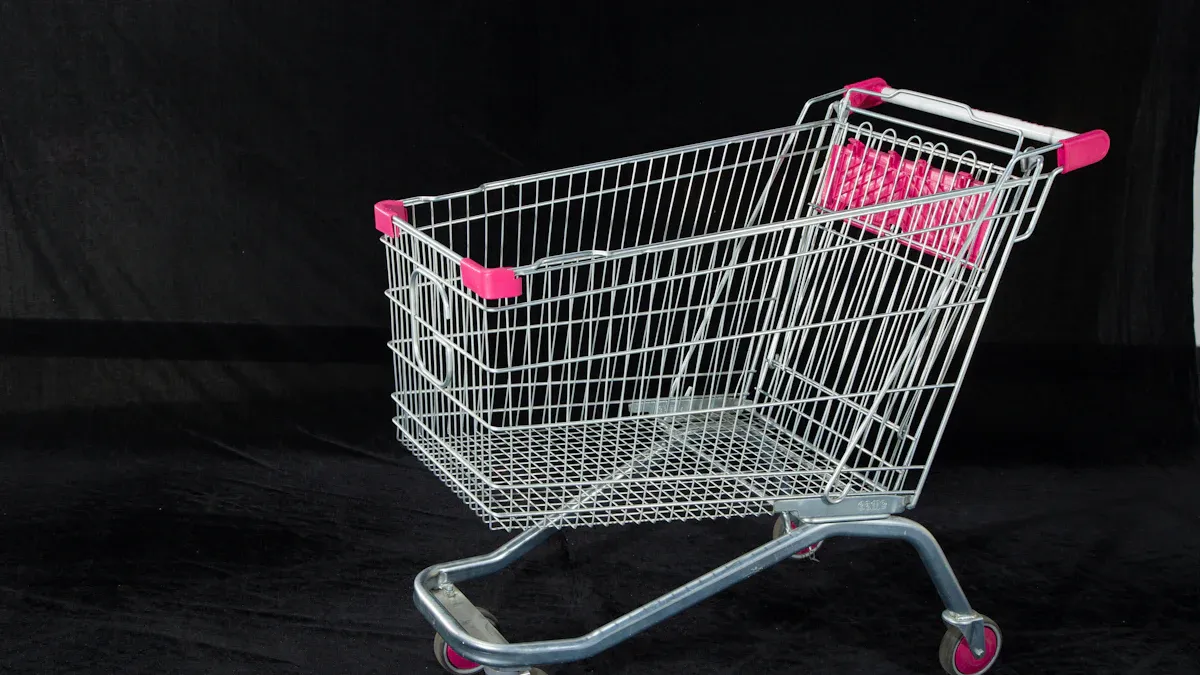Shopping Cart Unlock Methods

Shopping cart unlock methods play a vital role in ensuring carts are secure and used responsibly in retail spaces. You encounter these systems daily, whether at grocery stores or malls. They help prevent theft, promote organized shopping, and reduce operational challenges for businesses. From coin-based systems to modern contactless solutions, you can find various ways to unlock carts. Each method offers unique features, catering to different needs and preferences.
Key Takeaways
Coin systems are cheap and help keep carts in place.
App unlocks make shopping faster by skipping lines and tracking buys.
Key or token systems are safe and work with many token types.
Contactless systems are easy. Use your phone to unlock carts fast.
Pick the best cart unlock method based on cost, ease, and safety.
Coin-Based Shopping Cart Unlock Methods

How Coin-Based Systems Work
Coin-based shopping cart locks are one of the most traditional theft prevention methods used in retail environments. These systems require you to insert a coin or token into a slot on the cart to unlock it. Once you finish shopping and return the cart to its designated area, the system releases the coin or token back to you. This simple mechanism encourages customers to return carts to their proper locations, keeping parking lots and store entrances organized.
The system operates using a chain mechanism. Each cart is connected to the next with a small chain that locks into place. When you insert the required coin or token, the chain detaches, allowing you to use the cart. This straightforward design makes coin-based systems reliable and easy to maintain.
Advantages of Coin-Based Systems
Coin-based systems offer several benefits that make them a popular choice for shopping cart locks. These advantages include:
Cost Efficiency: Coin-based systems are affordable to install and maintain. They do not rely on advanced technology, which keeps operational costs low.
Simplicity: The mechanism is easy to understand and use. You only need a coin or token to unlock the cart, making it accessible to all age groups.
Encourages Cart Return: By requiring a deposit, these systems motivate you to return the cart to its designated area to retrieve your coin or token. This reduces the risk of shopping cart theft and keeps the store premises tidy.
Durability: The mechanical design ensures long-lasting performance with minimal maintenance.
Benefit | Evidence |
|---|---|
Cost Efficiency | A study found that blockchain-enabled cross-border payments could save businesses $10 billion by 2030. |
Security | Blockchain settlements are immutable, eliminating chargebacks and protecting businesses from revenue loss. |
Transparency | Blockchain technology provides a transparent ledger, enhancing trust in transactions. |
Additionally, stablecoins have gained popularity for their stability and security. They avoid the volatility of traditional cryptocurrencies while leveraging blockchain benefits, making them a reliable option for various applications.
Disadvantages of Coin-Based Systems
Despite their benefits, coin-based systems have some drawbacks that you should consider:
Limited Accessibility: Not everyone carries coins or tokens, which can inconvenience customers who arrive unprepared.
Vulnerability to Damage: The mechanical parts of the system can wear out over time, leading to malfunctions that require repairs.
Security Concerns: While effective for theft prevention methods, these systems are not foolproof. Determined individuals may find ways to bypass the mechanism.
Dependency on Coins or Tokens: The system relies entirely on the availability of coins or tokens. If you lose or forget them, you may face difficulty accessing a cart.
34% of studies on blockchain and Bitcoin highlight security challenges. Between September 2013 and September 2014, scams caused $11 million in losses, affecting 13,000 victims. Additionally, 54% of services that experienced DDoS attacks had anti-DDoS protection, while only 15% of those without attacks had such measures.
While coin-based systems remain a practical choice for many retailers, their limitations highlight the need for more advanced shopping cart locks in modern retail settings.
App-Based Shopping Cart Unlock Methods
How App-Based Systems Work
App-based shopping cart unlock methods use mobile applications to provide a seamless and modern shopping experience. You can download the store's app on your smartphone and register your account. Once inside the store, you scan a QR code or use Bluetooth to unlock a cart. The app connects to the cart and tracks your shopping activity in real time.
These systems often integrate advanced technologies like AI and RFID. For example:
AI algorithms and sensors monitor your cart, ensuring accurate billing without manual scanning.
This process eliminates the need for traditional checkout lines, saving time and enhancing convenience.
Benefits of App-Based Systems
App-based systems offer several advantages that improve your shopping experience:
Efficiency: You can skip long checkout lines, as the app handles billing automatically.
Accuracy: AI and sensors ensure precise tracking of items, reducing errors.
Convenience: You can unlock carts and shop using just your smartphone.
Benefit | Statistic |
|---|---|
Increase in average order value | |
Reduction in cart abandonment rates | 20% reduction from a simplified checkout process |
Increase in repeat customer rates | 15% increase from an interactive mobile cart experience |
These systems also help retailers combat shopping cart theft by linking carts to user accounts, making them harder to misuse.
Drawbacks of App-Based Systems
Despite their benefits, app-based systems have some limitations. Not everyone owns a smartphone or feels comfortable using apps, which can exclude certain customers. Technical issues, like app crashes or connectivity problems, may disrupt your shopping experience. Additionally, these systems require significant investment in technology, which may not suit all retail businesses.
While app-based methods offer many advantages, they may not be the best fit for every shopper or store. However, they represent a significant step forward in modernizing retail operations.
Key or Token-Based Shopping Cart Locks
How Key or Token-Based Systems Work
Key or token-based shopping cart locks offer a secure and practical way to manage carts in retail spaces. These systems require you to use a physical or digital token to unlock the cart. Tokens can take various forms, including smart cards, wearable devices, or mobile applications. Once you insert or scan the token, the cart unlocks, allowing you to shop freely.
The operational process varies depending on the type of token used. For example:
Type of Token | Description |
|---|---|
Connected tokens | Physical devices like smart cards and USB devices that users plug into their systems. |
Contactless tokens | Devices that communicate wirelessly with computers, such as wearable rings for seamless login. |
Disconnected tokens | Tokens that require users to manually enter a code for authentication, like two-factor authentication. |
Software tokens | Mobile applications that provide two-factor authentication, easier to use and manage than hardware. |
JSON Web Tokens (JWT) | Secure communication method using a digital signature and encryption for data verification. |
These systems enhance security by ensuring only authorized users can access carts. They also improve flexibility, allowing you to unlock carts without relying on coins or apps.
Pros of Key or Token-Based Systems
Key or token-based systems provide several benefits that make them a reliable choice for smart cart locks:
Improved Security: Tokens are harder to hack than traditional passwords. They expire after use, reducing the risk of shopping cart theft.
Enhanced Flexibility: You can access carts easily without re-entering credentials. This feature simplifies the shopping process.
User-Friendly Design: These systems accommodate various token types, ensuring compatibility with different technologies.
Durability: Physical tokens like smart cards are robust and less prone to damage compared to mechanical systems.
These advantages make key or token-based methods an excellent option for modern retail environments.
Cons of Key or Token-Based Systems
While these systems offer significant benefits, they also have some limitations:
Vulnerabilities: Automated attacks, such as credential stuffing or brute force attempts, can compromise security. Weak passwords or improper session invalidation may increase risks.
Complexity: Public key infrastructure (PKI) systems, which support token-based methods, often face challenges like legal framework issues and insufficient investment.
Economic Impact: Inefficiencies in digital identity systems can lead to information leakage and reduced effectiveness.
Aspect | Description |
|---|---|
PKI Issues | Public key infrastructure (PKI) has been criticized for complexity, legal framework challenges, and lack of investment. |
Digital Identity Systems | Italy's SPID and CIE systems illustrate vulnerabilities in centralized PKI systems, including information leakage and competition leading to inefficiencies. |
Economic Impact | Effective digital identity systems could unlock up to 6% of GDP in certain countries, highlighting the importance of addressing vulnerabilities. |
Despite these challenges, key or token-based systems remain a valuable tool for securing shopping carts and enhancing retail operations.
Contactless Shopping Cart Unlock Methods in Cloudpick's Unmanned Store

How Contactless Systems Work
Contactless shopping cart unlock systems represent the pinnacle of modern retail technology. These systems rely on advanced mechanisms like electromagnetic locks, which use an electromagnet and an armature plate to secure carts. When powered, the magnetic force keeps the lock engaged. To unlock a cart, you can use various authentication methods such as RFID, NFC, or even facial recognition. These technologies allow you to access carts without any physical contact, ensuring a seamless and hygienic experience.
Cloudpick's Unmanned Store takes this concept further by integrating these locks with AI-powered systems. For instance, the store's smart turnstiles use contactless methods to grant access, while the carts themselves are equipped with sensors that track your shopping activity. This integration enables real-time monitoring and management, ensuring that every cart operates efficiently and securely.
Tip: Contactless systems can also be controlled remotely. This feature allows store managers to lock or unlock carts and doors via software, enhancing security and operational flexibility.
Ease of Use of Contactless Systems
Contactless systems are designed with user convenience in mind. You can unlock a cart with a simple tap of your smartphone or a quick scan of a QR code. These systems eliminate the need for coins, keys, or tokens, making them accessible to everyone, including those who may not carry physical payment methods.
The efficiency of these systems extends beyond ease of use. They streamline retail operations by automating processes that traditionally required manual intervention. For example:
They reduce liability risks by ensuring compliance with safety standards.
They enhance operational efficiency by minimizing human error.
They achieve cost savings while maintaining high service standards.
Feature | Benefit |
|---|---|
Real-time tracking | Reduces mistakes in cart management and compliance. |
Automated reporting | Ensures seamless compliance without manual effort. |
Optimized asset utilization | Leads to significant cost savings in retail operations. |
Cloudpick's Unmanned Store demonstrates these benefits effectively. By using AI and IoT technologies, the store adapts to customer flow, reducing energy waste and ensuring optimal conditions for perishables. This not only enhances the shopping experience but also contributes to significant operational cost savings.
Limitations of Contactless Systems
While contactless systems offer numerous advantages, they are not without challenges. One limitation is the initial investment required for implementation. Advanced technologies like AI, RFID, and NFC can be costly to install and maintain, which may deter smaller retailers from adopting them.
Another challenge is the reliance on technology. If the system experiences technical issues, such as power outages or software glitches, it could disrupt operations. Additionally, not all customers may feel comfortable using high-tech solutions, especially those unfamiliar with smartphones or digital interfaces.
Despite these limitations, the benefits of contactless systems far outweigh the drawbacks. They provide a modern solution to traditional problems like shopping cart theft, ensuring a secure and efficient shopping environment. As technology continues to evolve, these systems will likely become more accessible and reliable, making them a staple in the future of retail.
Comparison of Shopping Cart Unlock Methods
Cost Comparison
When comparing the cost of shopping cart unlock methods, coin-based systems stand out as the most affordable option. These systems rely on simple mechanical parts, making them inexpensive to install and maintain. Key or token-based systems, while slightly more expensive, offer better security and durability, which can justify the higher upfront investment. App-based and contactless systems, like those used in Cloudpick's Unmanned Store, require advanced technology such as AI and IoT. These solutions involve higher initial costs but provide long-term savings by reducing operational expenses and improving efficiency.
Retailers must weigh the trade-off between upfront costs and long-term benefits. For smaller stores, coin-based systems may be sufficient. However, larger retailers or those in high-traffic areas might find the investment in app-based or contactless systems worthwhile due to their ability to streamline operations and enhance customer satisfaction.
Convenience Comparison
Convenience plays a crucial role in the effectiveness of shopping cart unlock methods. Coin-based systems are straightforward but can inconvenience you if you don’t have the required coin or token. Key or token-based systems improve on this by offering more flexibility, especially with digital tokens. App-based systems take convenience to the next level by allowing you to unlock carts with your smartphone, eliminating the need for physical items.
Contactless systems, like those in Cloudpick's Unmanned Store, offer the ultimate convenience. You can unlock carts with a simple tap or scan, saving time and effort. Research shows that 28% of customers want the checkout process completed within two minutes, and 66% prefer it done in under four minutes. Contactless systems meet these expectations by simplifying the shopping experience and reducing unnecessary steps.
Accessibility Comparison
Accessibility varies significantly across these methods. Coin-based systems are widely accessible due to their simplicity, but they may exclude customers who don’t carry coins. Key or token-based systems improve accessibility by offering multiple token options, including digital ones. However, they still require you to have the token on hand.
App-based and contactless systems excel in accessibility for tech-savvy users. You can unlock carts using smartphones, QR codes, or facial recognition. However, these methods may pose challenges for individuals unfamiliar with technology. Despite this, their ability to reduce cart theft and streamline operations makes them a valuable choice for modern retail environments.
Each shopping cart unlock method offers unique benefits. Coin-based systems are affordable and simple, while app-based methods provide efficiency and accuracy. Key or token-based systems enhance security and flexibility. Contactless solutions, like those in Cloudpick's Unmanned Store, redefine convenience with advanced AI integration.
Cloudpick's Unmanned Store allows you to shop without traditional checkouts. AI handles payments and inventory in real time. Partnerships with brands like 7-ELEVEn show its success, cutting labor costs by 75% and boosting satisfaction.
Choosing the best method depends on your priorities. If budget matters, coin-based systems work well. For convenience, app-based or contactless systems excel. With 41.8% of shoppers preferring mobile options, modern solutions meet evolving needs.
Statistic Type | Percentage/Value | Implication |
|---|---|---|
Mobile Shopping | 41.8% | Indicates the need for mobile optimization in shopping cart unlock methods. |
Cart Abandonment | 26% | Highlights the importance of a streamlined checkout process to reduce cart abandonment. |
Personalization | 49% | Shows the effectiveness of personalized recommendations in driving sales and enhancing user experience. |
Ultimately, contactless systems not only prevent shopping carts from misuse but also deliver a futuristic shopping experience.
FAQ
What is the purpose of shopping cart unlock methods?
Shopping cart unlock methods ensure carts are used responsibly. They prevent theft, reduce clutter, and improve organization in retail spaces. These systems also encourage you to return carts to designated areas, enhancing store efficiency.
How do contactless shopping cart systems work?
Contactless systems use technologies like RFID, NFC, or facial recognition. You can unlock carts without physical contact, ensuring a seamless experience. These systems often integrate with AI for real-time monitoring and efficient operations.
Are app-based shopping cart systems secure?
Yes, app-based systems are secure. They use encryption and user authentication to protect your data. Linking carts to user accounts also reduces the risk of theft or misuse.
What is a cart retrieval service?
A cart retrieval service helps stores recover misplaced or abandoned shopping carts. This service ensures carts remain available for customers and reduces operational inefficiencies caused by missing carts.
Which shopping cart unlock method is the most convenient?
Contactless systems offer the highest convenience. You can unlock carts with a simple tap or scan, eliminating the need for coins, keys, or tokens. These systems save time and enhance your shopping experience.
See Also
The Journey of Self-Checkout Technology Over Time
Common Self-Checkout Mistakes Encountered at Walmart
Easy Self-Checkout Strategies for Hassle-Free Garlic Purchases
Understanding Cash Issues at Self-Checkout and Their Fixes
The Way Cloudpick Introduces Cashier-Free Shopping Experiences
